JOHN PEARSON
(Born about 1720 - died 1762)
From submitted information it had been suggested that John Pearson was originally born in or near Barnard Castle, County Durham between 1st April and 5th March 1727, being baptised there, firstly on 5th March 1727 and then, a second baptism on 7th April 1728. To save confusion in dates - up until 1752, the New Year began on 1st April and not 1st January. From further information supplied by a co-researcher, Helen Slack, it seemed John Pearson was the son of William and Jane Pearson, William being native to Barnard Castle. Approximately six children were born to this couple between 1721 and 1735, all their baptisms taking place in Barnard Castle, and earlier family links, from William's father's generation, were linked to Staindrop, with records showing there around 1636.
In reality, it now seems that John Pearson was a native of Kelloe, County Durham, or at least spent many years there before moving 4 miles north - east to Ferryhill in the 1750s. Church records in Kelloe commenced from 1693, and from 26th February 1699 until 30th June 1837, a total of fifteen Pearson marriages occurred here at the parish church. 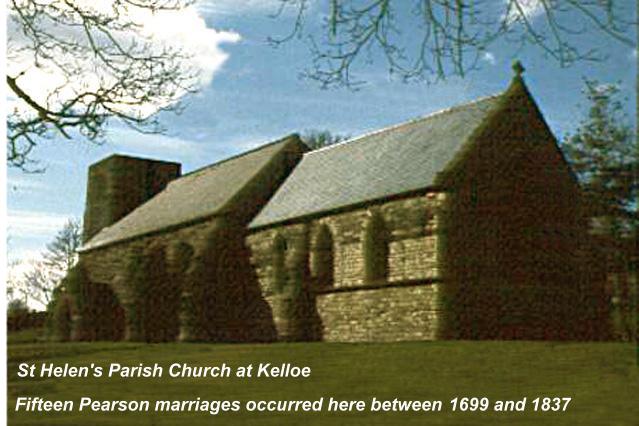 Kelloe is an Ancient Anglo - Saxon village and in the 11th Century, the Anglo-Saxon King Cnut
Kelloe is an Ancient Anglo - Saxon village and in the 11th Century, the Anglo-Saxon King Cnut
walked barefoot from near here to the shrine of St. Cuthbert. The church was actually built in the late 11th or 12th Century and was dedicated to St. Helena. It stands in a deep valley to the north of Kelloe Beck
The village of Kelloe takes its name from the Old English word "Celf-hlaw", meaning Calf hill, and is thick in limestone. All the villages around this area are situated on the Magnesium Limestone Hills which were at the bottom of a great lagoon, pushed to the surface by powerful earth movements in prehistoric times. The local limestone is a type called Dolomite and contains calcium and magnesium. These deposits were once used to cement the bricks at Durham Cathedral.
From research it is fair to suggest that the parents of John Pearson may have actually been named Anthony Pearson and Eleanor Hayn, these two marrying at Kelloe on 4th May 1718. John himself is believed to have married Catherine Cook at Kelloe on 12th May 1751, and shortly after, went to live in Wolsingham for a short time, where a daughter was born in 1752, named Eleanor, most likely after John's mother. Eleanor was also living in Witton Gilbert at the same time as John's son, Peter Pearson in the 1770s. It was here, at St. Michael's Church on 24th December 1774 that she wed a certain Roland Robinson.
From his movements between 1752 and 1761, it seems inevitable that John worked in one of two trades, those being a Woodman, and farm working. Indeed, both these occupations are highly noticeable in future Pearson generations from 1781 until 1930. By 1754, John was living in Ferryhill. At that time, this area was a farming district as it had been since the Bronze Age. The Ferryhill place-name comes from the Old English word "Fiergen" or "wooded hill", and means a settlement on a hill. The village itself developed around its long village green which runs east to west, and running east along the 18th Century Darlington to Durham turnpike road. One of the oldest buildings that John would have viewed in the village was the Manor House, built partly in the 1600s, and, in more recent times, subject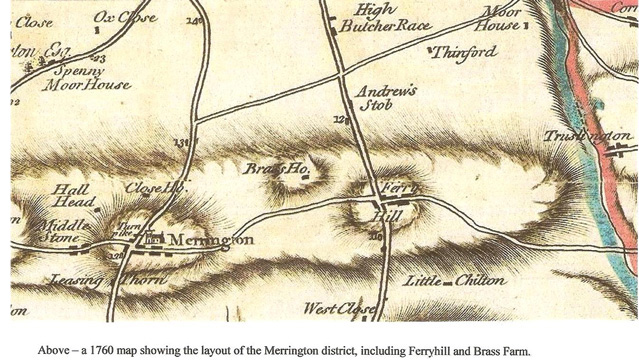 to haunting, believed to be the ghost of Andrew Mills, who in 1683, murdered the Brass family children at nearby Brass Farm. Following Mills' conviction, he was bound and placed in a Gibbet, also known as a Stob, where he died from cold and starvation in a field just north of Ferryhill. The stob stood between 1683 and 1860 until the area was ploughed over by one
to haunting, believed to be the ghost of Andrew Mills, who in 1683, murdered the Brass family children at nearby Brass Farm. Following Mills' conviction, he was bound and placed in a Gibbet, also known as a Stob, where he died from cold and starvation in a field just north of Ferryhill. The stob stood between 1683 and 1860 until the area was ploughed over by one
Mr. Laverick, a local farmer.
There is several building of 18 Century date in Ferryhill, like the Village Farmhouse, built in 1739. The area was part of Merrington Parish until 1843. Coal mining on a small scale was in operation at Ferryhill in Medieval times but, extensive coal mining never occurred here until the 19th Century.
The surname of Pearson is found in this village between AD 1150 and AD 1500, and is solely linked with farming.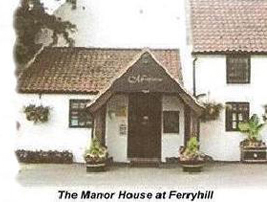
The actual spelling to be found shows as Persone. At beginning of the 1600’s Ferryhill consisted of just 8 houses and farmsteads in total. John Pearson’s son also named John was born in 1754 at Ferryhill, and was baptised at St. John’s Church in Kirk Merrington on the 8th April that year. The latter probably lived around the Ferryhill area all his life and is thought to have married Rebecca Busby at Kirk Merrington on the 9th October 1791.
Around 1756, a second daughter was born to John and Catherine Pearson, who was named after her mother. Like her sister Eleanor, young Catherine may be found in Witton Gilbert in 1774. It was here, on 2nd January that year, that she married Joseph Kirltey of Brancepeth.
By 1759, the Pearson family had moved to Butcher Race, on the outskirts of Hett, about 3 miles north of Ferryhill. This event began a long association with the area for the Pearson's, stretching to at least the 1880s. Butcher Race was so named as a result of the ambush and slaughter of a party of foraging Scots, shortly before the Battle of Neville's Cross in October 1346. It was at Butcher Race in the summer of 1759, that the birth of Peter Pearson occurred. The latter was a child of ill health, as is indicated by two baptism dates at St. John's Church in Kirk Merrington. These dates are listed as 10th September and 7th October 1759. The Butcher Race of John Pearson's time was very similar to life in Ferryhill, with farms and dense woodland spreading over the horizon.
Right – this view of Butcher Race shows the Coach and Horses public house.
The surrounding fields, in the 1700’s were dense woodland, and it was here John Pearson worked the land.
Back in the mid 18 Century, the surrounding area near Butcher Race consisted of Croxdale, Tudhoe, Thinford, and 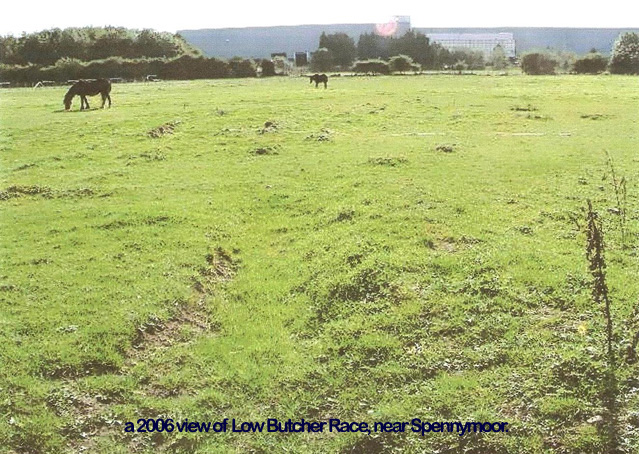 Hett, and further afield, Trustlington, Ferryhill, Merrington, and Spennymoor. Prominent buildings in the area were Moor House, Brass House, and Close House. During the Post-Medieval period of 1540 - 1900, Butcher Race was used mainly for Farm buildings and farming.
Hett, and further afield, Trustlington, Ferryhill, Merrington, and Spennymoor. Prominent buildings in the area were Moor House, Brass House, and Close House. During the Post-Medieval period of 1540 - 1900, Butcher Race was used mainly for Farm buildings and farming.
John Pearson still lived in the area in the 1760s, died at Low Butcher Race 20 May 1762.Athother son, Anthony Pearson was born near Butcher Race during 1761. The latter was baptised at Kirk Merrington in the October of that year and died at Moor House, Durham in 1824. At the turn of the 19th Century, Anthony was a farmer near Witton Gilbert. He had married Margaret Young at Brancepeth on 8th August 1785, she originating from Tanfield around 1763. Margaret herself died at Ushaw, Durham in 1822. Four children were born to this couple between 1786 and 1794, these being named Elizabeth (1786), Catherine (1789), Margaret (1791), and Anthony (1794)
It certainly seems that most of the offspring to John and Catherine Pearson had links to Witton Gilbert between 1770 and 1841. However, it is possible that Catherine herself was baptised there on 5th September 1725, the daughter of John Cook and Catherine Clark, these two marrying at St. Michael's on 7th September 1707. This is open to speculation at the moment, but this family of Cook are recorded in the village from at least 1707 until 1731. However, after 1734, there are no Cook marriages in Witton Gilbert until 1793, leading to speculation that they moved out of Witton Gilbert after 1734.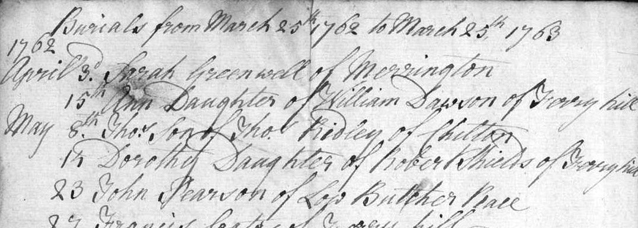
It is of note that the Catherine Cook of Witton Gilbert fame was one of nine found siblings baptised between 1707 and 1731, including a certain Peter Cook, baptised on 30th June 1728. It has been a mystery whom John and Catherine Pearson had actually named their son Peter Pearson after in 1759, and it seems probable that he may have been named after Catherine's brother.

The beautiful 12th Century church of St. Michael and All Angels at Witton Gilbert, which has been the focus for research from at least 1685 until 1907.
The offspring of JOHN PEARSON and CATHERINE COOK
ELEANOR PEARSON 1752 - unknown
Eleanor was the eldest child to John and Catherine, possibly being named after her Grandmother. It appears that Eleanor was born in Wolsingham in 1752 but may well have been baptised at Kirk Merrington. She lived at Butcher Race with her family in 1759, and can be found in Witton Gilbert in 1774, the year she married. Her wedding to Roland Robinson of Darlington took place at St. Michael's Church on 24 December that year. A daughter, whose name is uncertain, was also baptised here on that date.
JOHN PEARSON 1754 - after 1801
John was named after his father, being born at Ferryhill in 1754. His baptism occurred at St. John's Church in Kirk Merrington on 8 April that year. In 1759, John lived with his parents at Butcher Race and was still living near to here at the turn of the 19th Century. It is thought that he married Rebecca Bustin at Kirk Merrington on 9 October 1791, and they shared four children named Mary Pearson (1792), Jane Pearson (1795), Philip Pearson (1798 - cl842), and Hannah Pearson (1801).
CATHERINE PEARSON c1756 - unknown
Catherine's approximate birth year falls around 1756. She lived at Butcher Race in 1759, but can be found in Witton Gilbert in 1774, when she married Joseph Kirltey of Brancepeth on 2nd January that year. From their wedding details, it is shown that both Joseph and Catherine were illiterate.
PETER PEARSON 1759 -1841
See. P. Pearson 1759 within this site.
ANTHONY PEARSON 1761 -1824
Anthony was possibly named after his Grandfather, and was baptised at Kirk Merrington during October 1761. On 8 August 1785, Anthony married Margaret Young at Brancepeth. The latter was born in 1763 at Tanfield and died at Ushaw, Durham in 1822. By the turn of the 19th Century, Anthony and Margaret had a farm near Witton Gilbert. Anthony died at Moor House, Durham in 1824. They shared 7 offspring named Elizabeth Pearson (1786), Catherine Pearson (1789), Margaret Pearson (1791), and Anthony Pearson (1794), Thomas Pearson (born 22nd October 1802), Ann Pearson (born 8th June 1804) and James Pearson (born 4th April 1807).